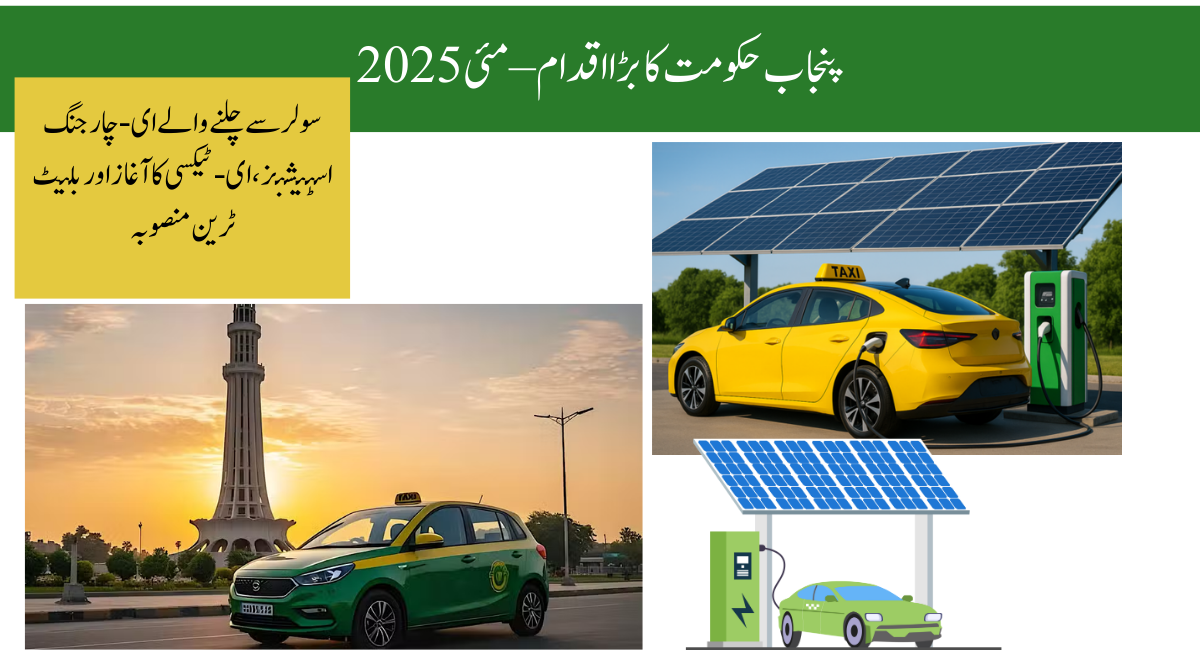Introduction
Punjab is undergoing a major transformation under the leadership of Chief Minister Maryam Nawaz, who has initiated a series of forward-looking projects focused on modernizing the transport sector and promoting renewable energy. These initiatives include the introduction of electric taxis, the installation of solar-powered EV charging stations, the launch of the Yellow Line Mass Transit Project, expansion of urban transit to other cities like Gujranwala, and the development of Pakistan’s first bullet train between Lahore and Rawalpindi.
Electric Taxi Pilot Project: A Greener Future for Public Transport
The Electric Taxi Pilot Project marks a milestone in Punjab’s strategy to reduce air pollution and enhance urban mobility. With 1,100 electric taxis to be introduced in the initial phase, the government aims to support drivers with financial subsidies and a supportive EV infrastructure. This initiative will not only cut carbon emissions but also reduce operational costs, making public transport more affordable and eco-friendly.
Solar-Powered EV Charging Stations: Clean Energy for Clean Transport
To support the shift to electric vehicles, the Punjab government is launching solar-powered EV charging stations across key urban centers. These stations will provide low-cost, renewable energy while reducing strain on the national grid. Cities like Lahore, Rawalpindi, Faisalabad, and Multan are prioritized in the first phase, aiming to make EVs more accessible and sustainable.
Read Also: How to Apply for CM Punjab Assan Karobar Card – New Scheme May 2025
Yellow Line Mass Transit Project: Revolutionizing Lahore’s Commute
The Yellow Line will connect Jinnah Terminal to Harbanspura, serving thousands of commuters daily. With the feasibility study already completed, construction is expected to begin soon. This project is designed to reduce congestion, offer faster travel, and improve air quality in Lahore. Integration with existing systems like the Metrobus and Orange Line will enhance passenger convenience.
Urban Transit Expansion Beyond Lahore
The success of the Yellow Line has encouraged plans to replicate similar transit systems in other cities, particularly Gujranwala. Feasibility studies are underway to develop tailored mass transit models for high-density routes in emerging urban areas, ensuring that growth and development are evenly distributed across Punjab.
Pakistan’s First Bullet Train: High-Speed Connectivity Between Lahore and Rawalpindi
Perhaps the most ambitious project is the proposed high-speed bullet train linking Lahore and Rawalpindi. A working group has been formed to conduct a feasibility study. This electric-powered train will cut travel time significantly and offer a modern, efficient, and safe alternative for inter-city travel. It is also expected to stimulate economic activity and tourism along its route.
Environmental and Economic Impacts
These projects collectively contribute to environmental sustainability by reducing carbon emissions and promoting clean energy. Economically, they create jobs, boost local business activity, and enhance the province’s investment appeal. Cleaner air also means better health outcomes and reduced healthcare costs.
Challenges and Solutions
Challenges include funding constraints, public resistance to change, and the need for skilled labor. The government plans to tackle these by promoting public-private partnerships, launching awareness campaigns, and offering training programs. Legal and regulatory updates are also being introduced to facilitate EV integration and solar infrastructure development.
Public-Private Partnerships (PPPs) for Sustainable Growth
The government encourages private sector involvement in construction, maintenance, and service operations to ensure efficiency and reduce the public financial burden. Transparent procurement processes and attractive investment policies are being developed to attract local and foreign investors.
Impact on Everyday Life and Social Inclusion
These transport upgrades will lead to shorter commutes, safer roads, and better access to education and employment. Low-income groups will benefit the most, as clean, affordable, and reliable transport becomes more widely available. This initiative also supports gender inclusion, as safer public transit encourages more women to participate in the workforce.
Alignment with Global Trends
Punjab’s transition to green mobility aligns with global efforts to combat climate change. By investing in electric vehicles, solar energy, and high-speed rail, the province positions itself as a regional leader in sustainable development and clean technology adoption.
Conclusion
Punjab’s 2025 transport and energy projects demonstrate a bold and visionary approach to building a cleaner, more inclusive, and economically vibrant province. Under CM Maryam Nawaz’s leadership, Punjab is on a fast track to becoming a model of sustainable urban development in South Asia.
FAQs
Q1: What is the goal of the electric taxi project in Punjab?
A1: The goal is to reduce air pollution and transport costs by replacing fossil fuel vehicles with electric taxis.
Q2: Where will the solar charging stations be installed?
A2: In major cities like Lahore, Rawalpindi, Faisalabad, and Multan, with plans to expand across Punjab.
Q3: What areas will the Yellow Line cover?
A3: It will connect Jinnah Terminal to Harbanspura, covering key commuter routes in Lahore.
Q4: How will the bullet train project impact travel?
A4: It will drastically cut travel time between Lahore and Rawalpindi and promote modern inter-city transport.
Q5: What economic benefits do these projects offer?
A5: They create jobs, reduce transport costs, attract investment, and improve access to markets and services.
